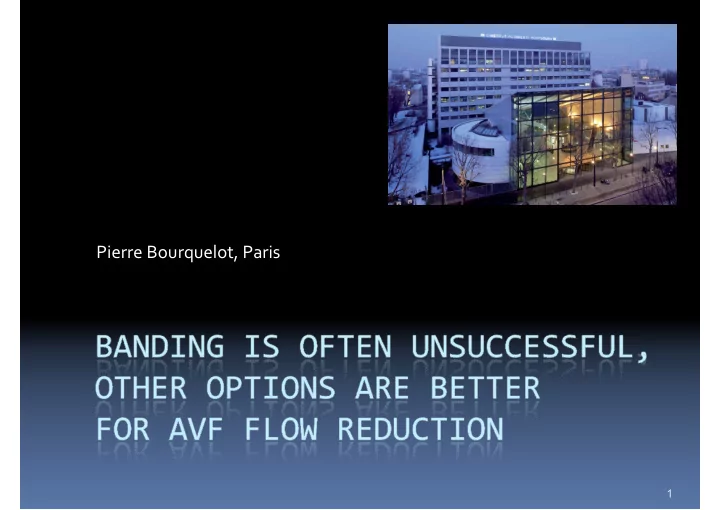

Pierre Bourquelot, Paris 1
I have no potential conflict of interest Pierre Bourquelot 2
Original Reduction Procedures
Proximal Radial Artery Ligation Retrograde Flow Proximal Artery Ligation Bourquelot P et al. Eur J Vasc Endovasc Surg 2010
Proximal Radial Artery Ligation Cephalic Vein Proximal Radial Artery Ligation Distal Radial Artery
Proximal Radial Artery Ligation P.Bourquelot et al. Eur J Vasc Endovasc Surg (2010) 7 Children 27 Adults 7 Children 27 Adults 2.451 mL/min 2.451 mL/min 1.883 mL/min 1.883 mL/min Flow Flow per 1.73 m² per 1.73 m ² per 1.73 m² ² per 1.73 m 50 % 11 53 % 16 Reduction rates Reduction rates 50 % 11 53 % 16
Proximal Radial Artery Ligation Patency rates 78% 74%
Brachial-based AVF High-Flow Reduction 1. Banding 2. Distalisation of the Artery Anastomosis 3. Revision Using Distal Inflow (RUDI) 4. Radial Artery Transposition 8
Banding is rarely effective, whatever the technique. Peroperative flowmetry may be inaccurate due to spasm More than 80% reduction of caliber is necessary 2 major post-operative risks : Persistent high flow Thrombosis Many patients with MILLER recurrent H-F referred to us and… 9
H-F Recurrence after Banding 50 patients, H-F > 2 L/min Brachial artery based AVF Reduction rate >50% initial flow Recurrent H-F (>2 L/min) developed in 52% of patients >2 L/min 2 L during a 1 year follow-up (upper curve). <2 L/min Risk factors were: • immediate post-banding flow >2L/min • young age Vaes Tordoir et al. JVS 2014 10
Brachial AVF High-Flow Reduction 1. Banding 2. Distalisation of the arterial anastomosis 3. RUDI 4. Radial Artery Transposition 11
Distalization of the arterial anastomosis • We reported that in 1989, at the 1 st Gore US Angioaccess meeting Bourquelot, P., Corbi, P., Cussenot, O. Surgical improvement of high-flow arteriovenous fistulas. in: B.G. Sommer, M.L. Henry (Eds.) Vascular access for hemodialysis. W.L. Gore & Associates Inc., Pluribus Press Inc, New York; 1989:124–130. 12
Distalization of the arterial anastomosis • We reported that in 1989, at the 1 st Gore US Angioaccess meeting • 21 patients, with high- flow elbow AVF, 6 mm thin-wall PTFE from the wrist to the elbow Bourquelot, P., Corbi, P., Cussenot, O. Surgical improvement of high-flow arteriovenous fistulas. in: B.G. Sommer, M.L. Henry (Eds.) Vascular access for hemodialysis. W.L. Gore & Associates Inc., Pluribus Press Inc, New York; 1989:124–130. 13
Distalization of the arterial anastomosis • We reported that in 1989, at the 1 st Gore US Angioaccess meeting • 21 patients, with high-flow elbow AVF, 6 mm thin-wall PTFE from the wrist to the elbow • Reduction rate: 50% 23 • No recurrence after 2years Bourquelot, P., Corbi, P., Cussenot, O. Surgical improvement of high-flow arteriovenous fistulas. in: B.G. Sommer, M.L. Henry (Eds.) Vascular access for hemodialysis. W.L. Gore & Associates Inc., Pluribus Press Inc, New York; 1989:124–130. 14
Brachial AVF High-Flow Reduction 1. Banding 2. Distalisation of the arterial anastomosis 3. RUDI 4. Radial Artery Transposition 15
RUDI (proximal radial artery) Minion et al. 2005 4 patients 2 to 3 cm distal to the brachial a. bifurcation Flow rates: not reported Too short distalization ? 16
RUDI (Proximal radial artery) Vaes et al. 2014 19 patients >2 L/min asymptomatic 6 to 8 cm extension 15 G Saphen.V. / 4 Basilic V. Vaes et al. JVA 2014 17
RUDI (Mid forearm radial artery) Initial reduction >50% During 1 year observation, the flow remained well Basilic V below 2 L/min except 3 pts. 2 L s p u o r g h t when the Basilic V. had o B GSV been used . Vaes et al. 2014 18
Brachial AVF High-Flow Reduction 1. Banding 2. Distalisation of the arterial anastomosis 3. RUDI 4. Radial Artery Transposition 19
Transposition of the Radial Artery We imagined TRA to avoid the risks of RUDI procedures: Dilatation of the upper radial artery, with recurrence of high- 1. flow Stenosis of the venous anastomosis of the PTFE/Vein with 2. fistula thrombosis The interposed vein or PTFE is replaced by the radial artery to increase the length and reduce the caliber 20
Transposition of the Radial Artery = Using preventive hemostasis with an inflatable tourniquet Previous arteriovenous anastomosis at the elbow is divided The radial artery is dissected free outside its two veins… Bourquelot JVS 2009 Bourquelot JVS 2009 21
Transposition of the Radial Artery …divided at the wrist and turned upwards to reach the vein above Transposed radial the elbow. artery The new anastomosis is performed using a microscope. N= 47 patients. Technical failures were treated by 2 redos and 2 abandons. Bourquelot JVS 2009 Bourquelot JVS 2009 22
Transposition of the Radial Artery Indications Bourquelot JVS 2009 Bourquelot JVS 2009 23
Reduction rate 43 patients (7>16 years, range 3- -82 ) 82 ) 43 patients (7>16 years, range 3 2 0.3 L/min per 1.73 m Mean preop.flow Mean preop.flow 2 0.3 L/min per 1.73 m² ² % 14 Men reduction rate 66% 14 Men reduction rate 66 Bourquelot JVS 2009 Bourquelot JVS 2009 24
Transposition of the Radial Artery No recurrence of high- Patency rates: flow was observed at 40% and 70% at 3 years 48 months 70% 40% Bourquelot JVS 2009 Bourquelot JVS 2009 25
Transposition of the Radial Artery 3 years later Bourquelot JVS 2009 Bourquelot JVS 2009 26
pierre@bourquelot.fr 27
Recommend
More recommend